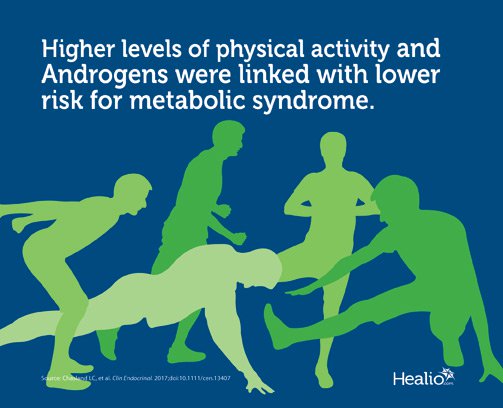Men with high androgen, physical activity levels at lower risk for metabolic syndrome
Researchers in Australia reported that men who participated in more physical activity and who had higher levels of testosterone or dihydrotestosterone were less likely to develop metabolic syndrome and die of cardiovascular disease.
“As men grow older, circulating testosterone concentrations decrease while incidence of cardiovascular disease increases,” Matthew W. Knuiman, PhD, of the School of Population Health at the University of Western Australia, Perth, and colleagues wrote. “Overweight older men have lower [testosterone] levels compared to normal weight men of the same age and reduced [testosterone] levels are associated with poorer health outcomes, including higher rates of metabolic syndrome and all-cause mortality. This has raised the question of whether reduced circulating [testosterone] might be a modifiable risk factor for cardiometabolic ill-health in aging men, with increasing interest and controversy regarding the possible role of pharmacological [testosterone] treatment as a means of preserving vascular health.”
The researchers obtained information on hours of physical activity per week (leisure/exercise, home and work), smoking and diabetes status, as well as medication use among 1,649 men, evaluating participants’ baseline serum testosterone, dihydrotestosterone and estradiol. Knuiman and colleagues stratified the men into several groups: high physical activity and high hormone, low physical activity and high hormone, high physical activity and low hormone, and low physical activity and low hormone.
Mean age at baseline was 49.8 years. During 20 years of follow-up, researchers reported 415 CVD events and 127 CVD-related deaths.
Men who showed higher levels of physical activity and higher testosterone or dihydrotestosterone were at lower risk for metabolic syndrome than those in the low physical activity and low hormone group, the researchers reported (OR = 0.17 for testosterone [P < .001]; OR = 0.26 [P < .001] for dihydrotestosterone).
Similarly, men with high physical activity and estradiol were also at lower risk for metabolic syndrome (high physical activity and high hormone vs. low physical activity and low hormone OR = 0.51; P = .001). Those with the highest levels of work, leisure or total physical activity and higher dihydrotestosterone were the least likely to die of CVD, Knuiman and colleagues wrote, while men with lower levels of physical activity and higher estradiol had the greatest risk for death from CVD.
“Overall, our results suggest that high [physical activity] and androgens, particularly [dihydrotestosterone], predict more favorable outcomes,” the researchers wrote. “Conversely, high [estradiol] and low [physical activity] predict less favorable outcomes. Key questions remain as to the direction of causation, and whether manipulation of both [physical activity] and hormone levels could modify cardiovascular risk.” – by Andy Polhamus
Disclosure: The researchers report no relevant financial disclosures.

